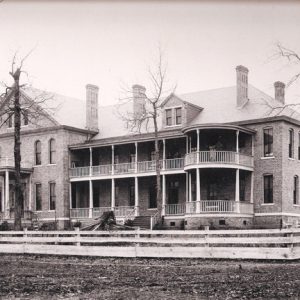calsfoundation@cals.org
Arkansas Confederate Home
The Arkansas Confederate Home was opened late in 1890 in a small remodeled residence on some sixty acres near Sweet Home (Pulaski County) through the efforts of the Ex-Confederate Association of Arkansas. This organization, composed of a group of philanthropic-minded Confederate veterans, founded the home to care for indigent Confederate veterans of the Civil War, along with their widows and orphans, in Arkansas. At its peak, it housed over 200.
On May 21, 1890, the Sweet Home site, consisting of sixty acres and a frame building, was purchased by the association for $3,000. The legislature made its first appropriation of $10,000 for the upkeep of the home in 1891. At that time, the facility included the original frame structure and two buildings referred to as “the barracks.” The home was maintained chiefly by private funds until it was sold to the state in 1892.
In 1903, two new buildings were constructed and an annex and hospital were added in 1907. The main building was remodeled in 1911.
Over the years, the number of residents living at the home steadily declined. By 1953, only forty-three Confederate widows occupied the home.
Bauxite mining, which threatened the grounds, was being conducted as early as the 1940s. In 1943, a commission was established by the legislature to determine the value of the ore on the home grounds. It was then determined that profits acquired from the lease of mineral rights would be used to construct a new home. By 1952, the mineral rights had been sold to the Dulin Bauxite Company, which began active mining in April. The next year, the legislature appropriated funds to build a permanent home on state property. In 1955, the old home was vacated, and a new, smaller facility was built on the grounds of the Schools for the Blind and Deaf in Little Rock (Pulaski County). The old buildings were razed.
By 1961, with only eight Confederate widows remaining there, the legislature decided to close the institution and transfer its remaining residents to area nursing homes. The home finally closed its doors in 1963, and the building was transferred to the Schools for the Blind and Deaf, where it was put into use for school purposes.
For additional information:
Arkansas Confederate Home Records. Arkansas State Archives, Little Rock, Arkansas.
Gaither, Zella Hargrove. Arkansas Confederate Home, Little Rock. Little Rock: New Era Press, 1920.
Green, B. W. “The Arkansas Confederate Home.” Confederate Veteran 31 (February 1923): 48.
Junkin, Blanche Chenault. “The History of Arkansas’ Confederate Home.” Arkansas Democrat Sunday Magazine, May 17, 1953, p. 2.
Kerley, Rachel. “The Arkansas Confederate Home.” Pulaski County Historical Review 63 (Winter 2015): 144–146.
Morgan, Sarah Elizabeth. “Confederate Home Doomed.” Arkansas Democrat Sunday Magazine, September 5, 1943, pp. 6–7.
Russell P. Baker
Arkansas History Commission and State Archives
 Civil War Pensions
Civil War Pensions Post-Reconstruction through the Gilded Age, 1875 through 1900
Post-Reconstruction through the Gilded Age, 1875 through 1900 United Confederate Veterans Reunion of 1911
United Confederate Veterans Reunion of 1911 Arkansas Confederate Home
Arkansas Confederate Home  Arkansas Confederate Home
Arkansas Confederate Home 




I worked in historical records on an environment lawsuit based on WWII bauxite mining, and I seem to remember that the home was displaced by the mining. It was controversial because the need for the bauxite soon decreased and the land was ultimately not needed.